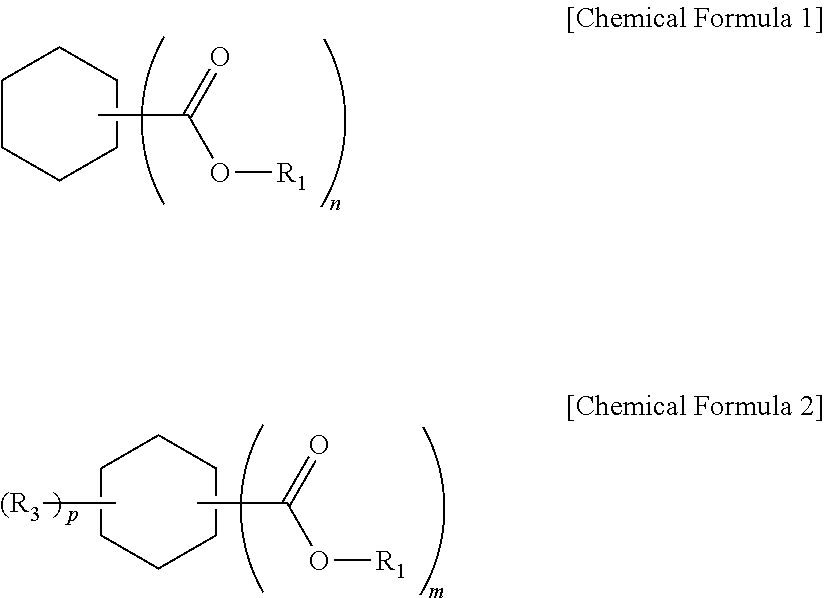Plasticizer composition comprising cyclohexane polyester-based substance and resin composition comprising the same
a technology of polyester-based substances and plasticizers, which is applied in the preparation of carboxylic acid esters, chemistry apparatus and processes, and organic chemistry, etc., can solve the problems of poor migration, low absorption rate of plasticizers, and high hardness or high sol viscosity, so as to ensure environmental friendliness, improve mechanical properties, and improve thermal stability
- Summary
- Abstract
- Description
- Claims
- Application Information
AI Technical Summary
Benefits of technology
Problems solved by technology
Method used
Image
Examples
example 1-1
[0117]A predetermined volume of a silica-supported palladium catalyst was held in a 1.5 L pressure vessel equipped with a stirrer, and 25 g of terephthalic acid as a reactant and 1 L of water were injected and stirred while injecting hydrogen by means of a mass flow meter. While the temperature inside the reaction vessel was raised up to 200° C. and an internal hydrogen pressure was maintained at 80 bar, the mixture was allowed to react for one hour. After completion of the reaction, a reaction product in the reaction vessel was recovered using methanol and purified. Afterward, esterification was performed in the presence of a Ti-based catalyst using 2-ethylhexanol in an amount of 300 mol % with respect to the hydrogenation product, followed by purification to obtain an ester product in the form of a composition.
example 1-2
[0118]A predetermined volume of a silica-supported palladium catalyst was held in a 1.5 L pressure vessel equipped with a stirrer, and 25 g of terephthalic acid as a reactant and 1 L of water were injected and stirred while injecting hydrogen by means of a mass flow meter. While the temperature inside the reaction vessel was raised up to 230° C. and an internal hydrogen pressure was maintained at 80 bar, the mixture was allowed to react for one hour. After completion of the reaction, a reaction product in the reaction vessel was recovered using methanol and purified. Afterward, esterification was performed in the presence of a Ti-based catalyst using 2-ethylhexanol in an amount of 300 mol % with respect to the hydrogenation product, followed by purification to obtain an ester product in the form of a composition.
examples 1-3 and 1-4
[0119]A predetermined volume of a silica-supported palladium catalyst was held in a 1.5 L pressure vessel equipped with a stirrer, and 25 g of terephthalic acid as a reactant and 1 L of water were injected and stirred while injecting hydrogen by means of a mass flow meter. While the temperature inside the reaction vessel was raised up to 230° C. and an internal hydrogen pressure was maintained at 80 bar, the mixture was allowed to react for two hours. After completion of the reaction, a reaction product in the reaction vessel was recovered using methanol and subjected to vacuum distillation such that the content of a perhydride was adjusted as shown in Table 1 below. Afterward, esterification was performed in the presence of a Ti-based catalyst using 2-ethylhexanol in an amount of 300 mol % with respect to the hydrogenation product, followed by purification to obtain an ester product in the form of a composition.
PUM
| Property | Measurement | Unit |
|---|---|---|
| speed | aaaaa | aaaaa |
| thickness | aaaaa | aaaaa |
| volume | aaaaa | aaaaa |
Abstract
Description
Claims
Application Information
 Login to View More
Login to View More - R&D
- Intellectual Property
- Life Sciences
- Materials
- Tech Scout
- Unparalleled Data Quality
- Higher Quality Content
- 60% Fewer Hallucinations
Browse by: Latest US Patents, China's latest patents, Technical Efficacy Thesaurus, Application Domain, Technology Topic, Popular Technical Reports.
© 2025 PatSnap. All rights reserved.Legal|Privacy policy|Modern Slavery Act Transparency Statement|Sitemap|About US| Contact US: help@patsnap.com



